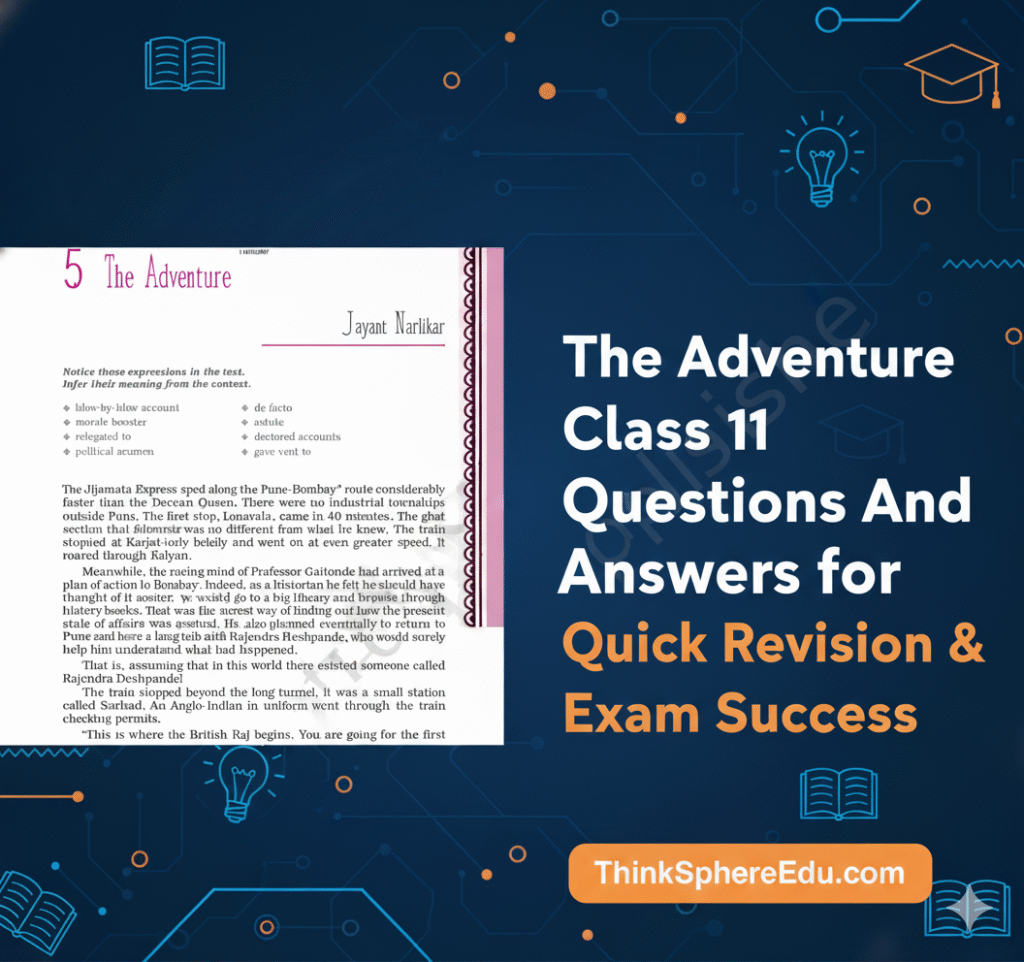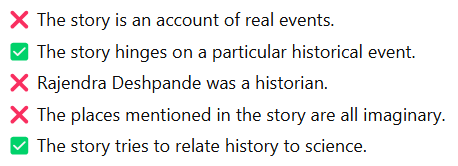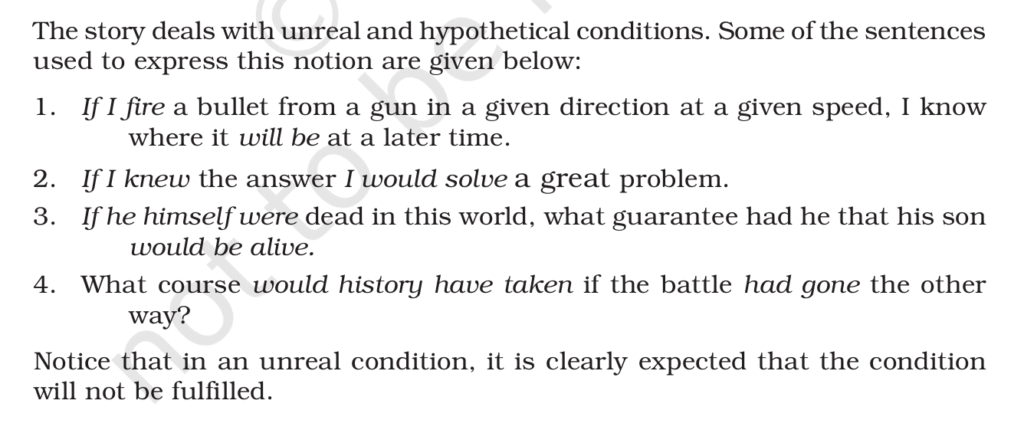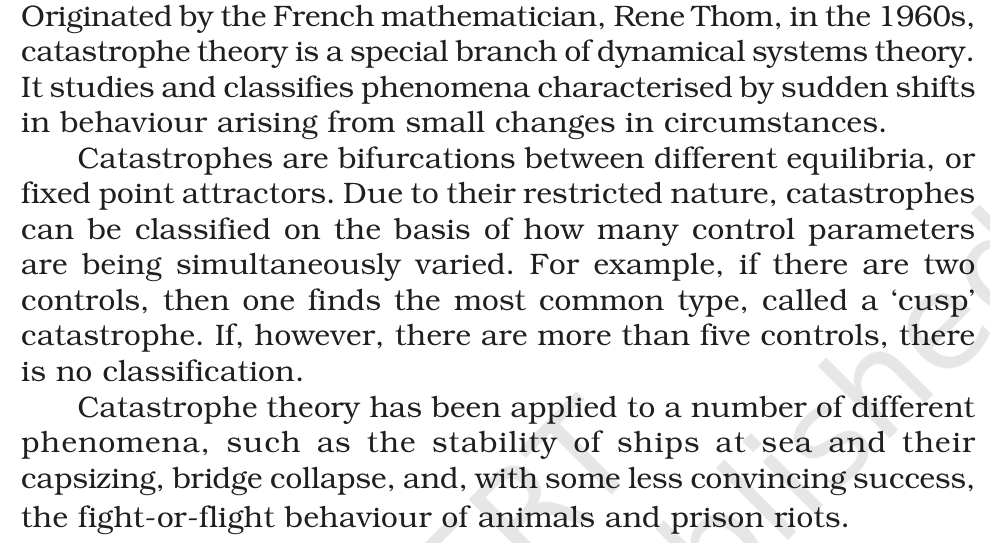
Hornbill | The Adventure Class 11 Questions and Answers Solved for Quick Revision & Exam Success | NCERT Solutions for Class 11 English. It is essential for young learners to build a strong foundation in the subject, and CBSE Class 11 English Solutions, Understanding the Chapter Thoroughly, helps students grasp key concepts, improve comprehension, and perform well in exams. Also, we provide The Adventure Class 11 Questions and Answers Solved and NCERT Class 11 English Sample Papers.
In this article we will provide you with the summary of The Adventure Class 11 in English, Hindi and Bengali.
Table of Contents
The Adventure Class 11 Questions And Answers Solved for Quick Revision & Exam Success
The Adventure class 11 summary in English:
The story “The Adventure” is written by Jayant Narlikar. It is about Professor Gaitonde, a historian from Pune, who experiences something strange and unbelievable.
One day, he was travelling from Pune to Bombay by the Jijamata Express. The train was very fast and he noticed that the surroundings looked different. When he reached Bombay, he saw that the city was under British rule. The East India Company was still active, and British officers were present everywhere. This surprised him because, according to the history he knew, the East India Company had ended after 1857.
To find out the truth, he went to the library of the Asiatic Society. There he read history books, including his own. Everything was the same until the last volume. In that book, he found that the Marathas had won the Third Battle of Panipat. In this world, Vishwasrao did not die, and that changed the entire course of Indian history. The Marathas became powerful, and the British never ruled India. India developed on its own and became modern and democratic.
Later, he went to Azad Maidan where a lecture was going on. When he saw the presidential chair empty, he went and sat there. The people got angry and threw things at him. Suddenly, he disappeared.
When he woke up, he was back in his own world after being hit by a truck. He told everything to his friend Rajendra Deshpande. Rajendra explained the incident through two scientific theories – Catastrophe Theory and Quantum Theory (Many Worlds Theory). He said that Gaitonde might have entered a parallel world where history had taken a different turn.
Professor Gaitonde realized that he had experienced another version of reality. He had also found proof – a torn page from Bhausahebanchi Bakhar – which described that Vishwasrao had survived the battle.
The Adventure class 11 summary in Hindi:
जयंत नार्लीकर द्वारा लिखित कहानी “द एडवेंचर” पुणे के एक इतिहासकार प्रोफ़ेसर गायतोंडे के बारे में है, जो एक अजीब और अविश्वसनीय अनुभव करते हैं।
एक दिन, वे जीजामाता एक्सप्रेस से पुणे से बंबई जा रहे थे। ट्रेन बहुत तेज़ थी और उन्होंने देखा कि आसपास का माहौल अलग दिख रहा था। बंबई पहुँचने पर, उन्होंने देखा कि शहर ब्रिटिश शासन के अधीन था। ईस्ट इंडिया कंपनी अभी भी सक्रिय थी, और ब्रिटिश अधिकारी हर जगह मौजूद थे। यह देखकर उन्हें आश्चर्य हुआ क्योंकि, उनके ज्ञात इतिहास के अनुसार, ईस्ट इंडिया कंपनी 1857 के बाद समाप्त हो गई थी।
सच्चाई जानने के लिए, वे एशियाटिक सोसाइटी के पुस्तकालय गए। वहाँ उन्होंने इतिहास की किताबें पढ़ीं, जिनमें उनकी अपनी भी शामिल थी। आखिरी खंड तक सब कुछ वैसा ही था। उस किताब में, उन्होंने पाया कि मराठों ने पानीपत का तीसरा युद्ध जीत लिया था। इस दुनिया में, विश्वासराव की मृत्यु नहीं हुई, और इसने भारतीय इतिहास की पूरी दिशा बदल दी। मराठे शक्तिशाली हो गए, और अंग्रेजों ने भारत पर कभी शासन नहीं किया। भारत अपने आप विकसित हुआ और आधुनिक और लोकतांत्रिक बना।
बाद में, वे आज़ाद मैदान गए जहाँ एक व्याख्यान चल रहा था। जब उन्होंने अध्यक्षीय कुर्सी खाली देखी, तो वे वहाँ जाकर बैठ गए। लोग क्रोधित हो गए और उन पर चीज़ें फेंकने लगे। अचानक, वे गायब हो गए।
जब उन्हें होश आया, तो वे एक ट्रक की टक्कर के बाद अपनी ही दुनिया में लौट आए थे। उन्होंने अपने मित्र राजेंद्र देशपांडे को सारी बात बताई। राजेंद्र ने इस घटना को दो वैज्ञानिक सिद्धांतों – प्रलय सिद्धांत और क्वांटम सिद्धांत (अनेक विश्व सिद्धांत) के माध्यम से समझाया। उन्होंने कहा कि गायतोंडे शायद एक समानांतर दुनिया में प्रवेश कर गए थे जहाँ इतिहास ने एक अलग मोड़ ले लिया था।
प्रोफ़ेसर गायतोंडे को एहसास हुआ कि उन्होंने वास्तविकता का एक अलग रूप देखा है। उन्हें इसका प्रमाण भी मिला था – भाऊसाहेबानची बखर का एक फटा हुआ पन्ना – जिसमें बताया गया था कि विश्वासराव युद्ध में बच गए थे।
The Adventure class 11 summary in Bengali:
“দ্য অ্যাডভেঞ্চার” গল্পটি লিখেছেন জয়ন্ত নার্লিকর। এটি পুনের একজন ইতিহাসবিদ অধ্যাপক গাইতোন্ডে সম্পর্কে, যিনি অদ্ভুত এবং অবিশ্বাস্য কিছু অভিজ্ঞতা লাভ করেন।
একদিন, তিনি জিজামাতা এক্সপ্রেসে পুনে থেকে বোম্বে যাচ্ছিলেন। ট্রেনটি খুব দ্রুত ছিল এবং তিনি লক্ষ্য করলেন যে চারপাশের পরিবেশ ভিন্ন দেখাচ্ছে। তিনি যখন বোম্বে পৌঁছান, তখন তিনি দেখতে পান যে শহরটি ব্রিটিশ শাসনের অধীনে। ইস্ট ইন্ডিয়া কোম্পানি এখনও সক্রিয় ছিল এবং ব্রিটিশ অফিসাররা সর্বত্র উপস্থিত ছিলেন। এটি তাকে অবাক করে কারণ, তার জানা ইতিহাস অনুসারে, ইস্ট ইন্ডিয়া কোম্পানি ১৮৫৭ সালের পরে শেষ হয়ে গিয়েছিল।
সত্য জানতে, তিনি এশিয়াটিক সোসাইটির লাইব্রেরিতে যান। সেখানে তিনি ইতিহাসের বই পড়েন, যার মধ্যে তার নিজের বইও ছিল। শেষ খণ্ড পর্যন্ত সবকিছু একই ছিল। সেই বইতে তিনি দেখতে পান যে মারাঠারা পানিপথের তৃতীয় যুদ্ধে জয়লাভ করেছে। এই পৃথিবীতে, বিশ্বরাও মারা যাননি, এবং এটি ভারতীয় ইতিহাসের পুরো গতিপথ পরিবর্তন করে। মারাঠারা শক্তিশালী হয়ে ওঠে, এবং ব্রিটিশরা কখনও ভারত শাসন করেনি। ভারত নিজেরাই বিকশিত হয়েছিল এবং আধুনিক এবং গণতান্ত্রিক হয়ে ওঠে।
পরে, তিনি আজাদ ময়দানে যান যেখানে একটি বক্তৃতা চলছিল। যখন তিনি রাষ্ট্রপতির চেয়ার খালি দেখতে পান, তিনি সেখানে গিয়ে বসেন। লোকেরা রেগে যায় এবং তার দিকে জিনিসপত্র ছুঁড়ে মারে। হঠাৎ, তিনি অদৃশ্য হয়ে যান।
যখন তিনি জেগে ওঠেন, তখন একটি ট্রাকের ধাক্কায় তিনি তার নিজের জগতে ফিরে আসেন। তিনি তার বন্ধু রাজেন্দ্র দেশপাণ্ডেকে সবকিছু বলেন। রাজেন্দ্র দুটি বৈজ্ঞানিক তত্ত্বের মাধ্যমে ঘটনাটি ব্যাখ্যা করেন – বিপর্যয় তত্ত্ব এবং কোয়ান্টাম তত্ত্ব (অনেক বিশ্ব তত্ত্ব)। তিনি বলেছিলেন যে গাইতোন্ডে হয়তো এমন একটি সমান্তরাল জগতে প্রবেশ করেছিলেন যেখানে ইতিহাস ভিন্ন মোড় নিয়েছিল।
অধ্যাপক গাইতোন্ডে বুঝতে পেরেছিলেন যে তিনি বাস্তবতার অন্য সংস্করণ অনুভব করেছেন। তিনি প্রমাণও খুঁজে পেয়েছিলেন – ভৌসাহেবাঞ্চি বাখরের একটি ছেঁড়া পাতা – যেখানে বর্ণনা করা হয়েছে যে বিশ্বশ্রাব যুদ্ধে বেঁচে গিয়েছিলেন।
Also Read
- Class 11 English NCERT Solutions Hornbill 2025-26 | Chapter wise free pdf answers
- The Portrait of A Lady Class 11 Questions With Answers Solved
- The Laburnum Top Questions And Answers | Hornbill
Understanding the text: (The Adventure Class 11 Questions and Answers)
I. Tick the statements that are true.
- The story is an account of real events.
- The story hinges on a particular historical event.
- Rajendra Deshpande was a historian.
- The places mentioned in the story are all imaginary.
- The story tries to relate history to science.
Answer:

II. Briefly explain the following statements from the text.
1. “You neither travelled to the past nor the future. You were in the present experiencing a different world.”
Explanation:
Rajendra tells Professor Gaitonde that he did not actually go back or forward in time. Instead, he entered a parallel world where history had taken a different turn – a world where the Marathas had won the Battle of Panipat. So, both worlds existed at the same time, but he experienced a different version of the present.
2. “You have passed through a fantastic experience: or more correctly, a catastrophic experience.”
Explanation:
Rajendra says this because Professor Gaitonde’s strange journey can be explained by catastrophe theory. This theory says that a small change in events can create big, sudden effects. The Battle of Panipat was such a “catastrophe point.” Gaitonde’s experience of moving between two different outcomes of that event was, therefore, a catastrophic experience.
3. Gangadharpant could not help comparing the country he knew with what he was witnessing around him.
Explanation:
When Professor Gaitonde saw the alternate India where the Marathas had won and the British had not ruled, he compared it with the India he knew. He noticed that this new India was free, strong, self-respecting, and developed – unlike the India that had suffered under colonial rule.
4. “The lack of determinism in quantum theory!”
Explanation:
This means that in quantum theory, the behavior of tiny particles like electrons cannot be predicted with certainty. Their position or motion can only be guessed in terms of probability. Rajendra used this idea to explain that there could be many possible worlds existing at once, just like different possibilities in atomic behavior.
5. “You need some interaction to cause a transition.”
Explanation:
Rajendra says that to move from one world to another (a transition between realities), some powerful event or trigger is needed. In Gaitonde’s case, this might have been the collision with the truck or his intense thinking about the Battle of Panipat and catastrophe theory at that moment. This interaction caused him to shift from one world to another.
Talking about the text: (The Adventure Class 11 Questions and Answers)
1. Discuss the following statements in groups of two pairs, each pair in a group taking opposite points of view.
(i) A single event may change the course of the history of a nation.
Discussion:
- For: A single event may change the course of the history of a nation. The story clearly shows that one small event – Vishwasrao not dying in the Battle of Panipat – completely changed Indian history. The Marathas won, the British could not rule India, and the country became strong and independent. This proves that one single event can change the destiny of an entire nation.
- Against: The statement that “A single event may change the course of the history of a nation” is based on perspective only. It is a relative truth. We cannot just claim that anyone course of events is a reality because there could be alternative outcomes of a single event in history. Even if Vishwasrao had survived, other political, social, and economic forces might have changed the outcome later. So, one event alone cannot decide the future of a whole nation.
(ii) Reality is what is directly experienced through the senses.
Discussion:
- For: Professor Gaitonde actually saw, heard, and experienced everything in the alternate world – the East India Company, British officers, and the new Bombay. For him, it was real because his senses proved it. So, reality can be defined by what we experience directly.
- Against: Rajendra’s explanation shows that there can be many realities existing at the same time. What one person experiences may not be the only truth. Science (quantum theory) proves that there can be multiple versions of reality, even if we cannot sense them all.
(iii) The methods of inquiry of history, science and philosophy are similar.
Discussion:
- For: All three deal with searching for truth. In the story, Gaitonde used historical research to find how the Marathas won, and Rajendra used scientific theories to explain it. Both tried to find logical answers to the same mystery, showing that their methods of reasoning and investigation are similar.
- Against: History is based on facts, records, and evidence of the past, while science depends on experiments, observation, and proof. Philosophy, on the other hand, deals with reasoning and abstract ideas. So, their methods may aim at truth but are not exactly the same.
2.
(i) The story is called ‘The Adventure’. Compare it with the adventure described in ‘We’re Not Afraid to Die…’
Answer:
In “The Adventure” by Jayant Narlikar, the adventure is intellectual and scientific. Professor Gaitonde experiences a strange journey into an alternate reality, where history has taken a different turn – the Marathas defeated the British in the Battle of Panipat. His adventure lies in exploring the mystery of time, space, and reality. It is not a physical risk but a mental and scientific exploration that connects history with quantum theory.
On the other hand, in “We’re Not Afraid to Die… if We Can All Be Together” by Gordon Cook and Alan East, the adventure is physical and life-threatening. The story tells about a family’s real-life struggle against the sea when their boat is destroyed by giant waves. They fight to survive in the middle of the ocean, showing courage, determination, and teamwork.
(ii) Why do you think Professor Gaitonde decided never to preside over meetings again?
Answer:
Prof. Gaitonde experiences a completely different consequence of the Battle of Panipat where the Marathas emerge victoriously and then they extend their influence all over the country. His mind witnesses a different version of a historical event. However, he also experiences an event that does not conform to the conventions. The event is actually a lecture session on the outcome of the Battle of Panipat.
Prof. Gaitonde observes that the President’s chair was vacant which was contrary to the conventions and he rushed to occupy the chair. He then starts to explain why there is a need for a President in a lecture session like this one. The public gets mad and starts throwing things at him. He has a horrible experience and thus decides not to preside over meetings again.
Thinking about language: (The Adventure Class 11 Questions and Answers)
1. In which language do you think Gangadharpant and Khan Sahib talked to each other? Which language did Gangadharpant use to talk to the English receptionist?
Answer:
Gangadharpant and Khan Sahib probably talked in Marathi or Hindustani (Hindi-Urdu mix), as both were Indian and could easily understand each other. When Gangadharpant spoke to the English receptionist, he must have used English, because that was the language commonly used for communication with British officials or staff at that time.
2. In which language do you think Bhausahebanchi Bakhar was written?
Answer:
Bhausahebanchi Bakhar was most likely written in Marathi, as Bakhar is a traditional form of Marathi historical prose used in Maharashtra to record historical events and heroic deeds.
3. There is mention of three communities in the story: the Marathas, the Mughals, the Anglo-Indians. Which language do you think they used within their communities and while speaking to the other groups?
Answer:
The communities used local languages such as Marathi, Hindi, or Sindhi to communicate among themselves. However, they would all use English when communicating with each other.
4. Do you think that the ruled always adopt the language of the ruler?
Answer:
No, not always. The ruled people may learn the ruler’s language for official or practical purposes, but they usually continue to use their own native language in daily life, traditions, and culture. For example, even during British rule, most Indians still spoke their regional languages like Hindi, Bengali, Tamil, or Marathi, while using English only for education and administration.
Working with words: (The Adventure Class 11 Questions and Answers)
I. Tick the item that is closest in meaning to the following phrases.
1. to take issue with
- (i) to accept
- (ii) to discuss
- (iii) to disagree
- (iv) to add
Answer: (iii) to disagree ✅
2. to give vent to
- (i) to express
- (ii) to emphasise
- (iii) suppress
- (iv) dismiss
Answer: (i) to express ✅
3. to stand on one’s feet
- (i) to be physically strong
- (ii) to be independent
- (iii) to stand erect
- (iv) to be successful
Answer: (ii) to be independent ✅
4. to be wound up
- (i) to become active
- (ii) to stop operating
- (iii) to be transformed
- (iv) to be destroyed
Answer: (ii) to stop operating ✅
5. to meet one’s match
- (i) to meet a partner who has similar tastes
- (ii) to meet an opponent
- (iii) to meet someone who is equally able as oneself
- (iv) to meet defeat
Answer: (iii) to meet someone who is equally able as oneself ✅
II. Distinguish between the following pairs of sentences.
1. (i) He was visibly moved.
(ii) He was visually impaired.
Answer:
- (i) He was visibly moved – means he was emotionally touched, and his feelings could be seen clearly on his face or in his behavior.
- (ii) He was visually impaired – means he had a problem with his eyesight or was partially/fully blind.
2. (i) Green and black stripes were used alternately.
(ii) Green stripes could be used or alternatively black ones.
Answer:
- (i) Green and black stripes were used alternately – means green and black stripes were placed one after another in a regular pattern (first green, then black, then green again, and so on).
- (ii) Green stripes could be used or alternatively black ones – means either green stripes or black stripes could be chosen, suggesting a choice between the two options, not a pattern.
3. (i) The team played the two matches successfully.
(ii) The team played two matches successively.
Answer:
- (i) The team played the two matches successfully – means the team won or performed well in both matches.
- (ii) The team played two matches successively – means the team played the two matches one after the other without a break, regardless of whether they won or lost.
4. (i) The librarian spoke respectfully to the learned scholar.
(ii) You will find the historian and the scientist in the archaeology and natural science sections of the museum respectively.
Answer:
- (i) The librarian spoke respectfully to the learned scholar – means the librarian showed respect in the way he spoke to the scholar, focusing on manner of speaking.
- (ii) You will find the historian and the scientist in the archaeology and natural science sections of the museum respectively – means the historian is in the archaeology section and the scientist is in the natural science section, showing correct matching or arrangement of people with places.
Noticing form: (The Adventure Class 11 Questions and Answers)

Answer:
Things to do: (The Adventure Class 11 Questions and Answers)
1. Read the following passage on the Catastrophe Theory downloaded from the internet.

2. Look up the Internet or an encyclopedia for information on the following theories.
- Quantum theory
- Theory of relativity
- Big Bang theory
- Theory of evolution
Answer:
